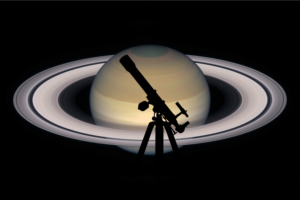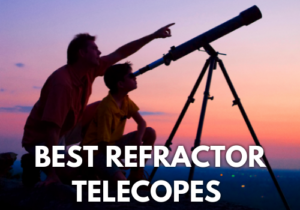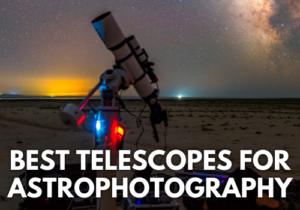
7 Best Intermediate Telescopes 2026; Reviews
Disclosure: This post contains affiliate links and I may earn a small commission (at no extra cost to you) if you click through and make a purchase. Thanks in advance – I really appreciate it!
Here in this “Best Intermediate Telescope” article we’ve rounded up 7 of the best telescopes of various types, specifications, and budget perfectly suited to be used by someone looking to level up. Below, you’ll find in-depth reviews of each, as well as an elaborate buying guide to help you pick out the one that suits you the most.
Our Top 3 Picks
If you are a beginner in astronomy and want to transition from a basic scope to an intermediate telescope then we assure you, you have landed on the right page.
Since there are so many options available in the market today, we did a survey among fellow astronomy enthusiasts, and consulted 2 experts and came up with 12 popular categories of intermediate telescopes.
We then took a look at the entire popular telescope market, we combed through the details and customer reviews for dozens of scopes and chose the best intermediate telescope in each of the 11 shortlisted categories.
We’ve also included an Intermediate telescope buying guide. If you want to learn more about telescopes before you buy, or just want to make sure you’re getting good value for your money, be sure to check it out.
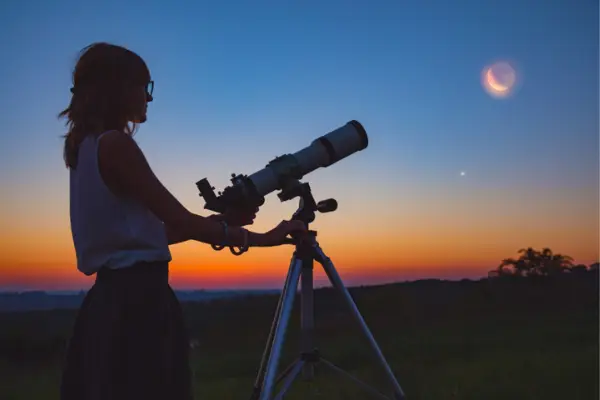
Best Intermediate Telescope
With so many models with so many features available today, it can be a tedious task to find the best intermediate telescope. We have analyzed the main features ( aperture, focal length, ratio, portability, affordability etc.) that make a good telescope for intermediates that you can use to enjoy the night sky and fulfill your love for astronomy.
1. Celestron – AstroMaster 130EQ
- POWERFUL TELESCOPE FOR ASTRONOMY BEGINNERS: The AstroMaster 130EQ-MD delivers sharp optics, a stable equatorial mount, motorized tracking, and easy operation, making it the top choice for beginners ready to explore the night sky.
- HIGH-QUALITY 130MM OPTICS: Enjoy views through the 130mm (5”) Newtonian reflector, which features high-quality aluminum and SiO₂ coatings and enough light-gathering ability to view all the best celestial objects.
- SMOOTH, ACCURATE POINTING: Effortlessly aim and center your target using the two slow-motion control knobs for right ascension and declination whether you’re observing planets or deep-sky objects.
- MOTOR DRIVE FOR AUTOMATIC TRACKING: Once centered, let the included RA motor drive take over to automatically follow celestial objects as they move across the sky — keeping them perfectly in view without constant manual adjustments.
- QUICK SETUP: With just a few key parts to assemble, you can go from box to backyard in minutes—no tools required. The sturdy, adjustable tripod provides stable, comfortable viewing tailored to your height, perfect for adults or kids, standing or seated.
The Celestron PowerSeeker 127EQ telescope is a Newtonian reflector, which means it uses mirrors to gather the light of the skies, and reflects it for viewing. With mirrors being much less expensive to produce than glass lenses, reflector telescopes offer more value in terms of inches of aperture.
The PowerSeeker 127EQ comes with two eyepieces (4mm and 20mm) and a 3x Barlow lens.
The 5-inch mirror on the 127mm PowerSeeker model limits useful magnification to about 250x, which is achieved using the 4mm eyepiece.
The larger 20mm eyepiece provides a more useful 50x magnification. This grows to 150x when coupled with the 3x Barlow.
If you’re considering an additional eyepiece, something like a 15mm Plossi would be a good option. This provides you with 66x magnification, or 198 when coupled with the Barlow.
The telescope is ideal for near and deep-sky observation, Celestron’s PowerSeeker 127EQ 127mm f/8 Reflector Telescope features a respectable focal length and a large, parabolic mirror that produce detailed images of the Moon, clear views of the planets, and the ability to resolve bright distant objects such as nebulae and galaxies.
The beauty of a Newtonian telescope is the longer focal lengths which can be offered in much shorter tube sizes—1000mm focal length in a tube which is only 20 inches (508mm) long .
The PowerSeeker 127EQ is highly portable and one of the best intermediate telescope for adults & teenagers alike. You could easily fit this telescope and tripod in the trunk of a car and still have room for your other equipment, or maybe a late night picnic.
Additionally, you receive a copy of Starry Night astronomy software with a database of over 10,000 celestial objects.
Considering the telescope’s low price, compromises had to be made, and one such compromise is the use of a spherical mirror rather than a parabolic mirror.
Optical aberrations tend to be more common with spherical mirrors. This telescope does, however, feature an erect image diagonal for the right way up images, which prevents some aberration.
This telescope comes with an Equatorial mount, designed for astronomy telescopes. Included are two manual slow-motion controls, these allow for smoother tracking of objects as they pass across the night sky.
The tripod is made of aluminum, although lightweight, it is robust, solid and also comes with a very handy accessory tray which lets you keep extra eyepieces and T-rings for a camera, close to hand.
Pros:
- Solid build quality
- Stable mount
- Comes with a 3x Barlow lens
Cons:
- Spherical mirror leads to some amount of aberrations
- Occasional collimation of the mirrors required
2. Celestron – NexStar 6SE
- ADVANCED TECH MEETS ICONIC DESIGN: The NexStar 6SE pairs Celestron’s legendary orange tube with a fully computerized GoTo system—ideal for those ready to step up from manual scopes and explore more of the night sky with precision and ease.
- 6-INCH SCHMIDT-CASSEGRAIN OPTICS: The large 6" aperture gathers enough light to reveal fine lunar details, cloud bands on Jupiter, and deep-sky objects like galaxies and globular clusters—all in a compact, portable form factor.
- FULLY AUTOMATED GoTo MOUNT WITH NEXSTAR+ HAND CONTROL: Use the NexStar+ hand control to select from a 40,000+ object database. The computerized mount then automatically slews to your target and tracks it—no star charts or manual alignment needed.
- FAST & EASY ALIGNMENT WITH SKYALIGN TECHNOLOGY: SkyAlign gets you observing fast—just center any three bright stars or planets, even if you don’t know their names. The system then calculates your position and aligns the mount in minutes.
- COMPATIBLE WITH CELESTRON ACCESSORIES: Easily upgrade your setup with all our latest accessories to enhance automation, wireless control, or location accuracy as your skills grow.
The NexStar 6SE offers consumers the proven quality of the Celestron brand in a compact, portable, and technologically advanced telescope.
The scope’s 6-inch aperture, portable design, fully functional computer, and extensive database, among other features, make it easy to use, easy to transport, and easy to enjoy regardless of experience level. The NexStar 6SE is quite evidently the best celestron telescope under $1000 on our list.
The NexStar 6SE is a 6-inch Schmidt Cassegrain Telescope, which has an actual aperture of 150 mm and focal length of 1,500 mm, giving it a focal ratio of f/10. The OTA comes on a Vixen-style dovetail bar, which fits into the dovetail saddle on the mount.
The telescope also comes with a 1.25” prism diagonal, 25 mm Plossl eyepiece (providing 60x when used with the 6SE) and Celestron’s StarPointer, which is a zero-power red-dot-style finder.
The Celestron NexStar 6 SE is a solid and sturdy telescope, perfect for home use and astrophotogaphy.
The Celestron NexStar 6 SE is easy to align with Celestron’s SkyAlign Go-To Alignment system.
On average it takes a new telescope user approximately 5 minutes to do a full sky alignment with the NexStar 6 SE.
Once aligned, the telescope is incredibly easy to operate. The hand controller on the NexStar 6SE allows you to move the telescope at your discretion. If you are looking for a telescope that can help you transition from beginner to a bit advanced astronomer without much guidance then look no further than the NexStar 6SE as it one of the best rated intermediate telescope that money can buy.
The NexStar 6SE’s hand controller offers a tour of the night sky and easily allows you to locate planets, galaxies or any of the 40,000 celestial objects in its database.
To power the 6SE you have two options, 8x AA batteries or 12v DC power supply. The 8x AA batteries would last you about 3 hours (included alignment of finderscope and general terrestrial viewing and the 40 minute observation session).
You can download all the available upgrades from Celestron’s website. In this way, you can keep your telescope up to date, and you can even control your telescope via computer.
The 6SE makes a good choice for consumers living in areas with light-pollution who are looking for clarity and accuracy in their viewing experience.
It is also one of the best telescopes for beginners under $1000 who are willing to invest a fair sum of money into the hobby in order to learn more about the star gazing experience. Also, the 6SE is a good choice even for more experienced star gazers who wish to have a more portable scope for easier transport and for viewing deep space objects.
Pros:
- Easy to mount and to use
- Good optics
- It’s very sturdy and low maintenance
- Motorised and automated GoTo mount
- Portable, fits perfectly in the back of any normal car
Cons:
- 8 AA batteries tend to drain out fairly quickly
- User manual and instructions are not very clear
Related
3. Celestron – NexStar 127SLT
- COMPUTERIZED STAR LOCATING TELESCOPE: The Celestron NexStar 127SLT offers a database of more than 40,000 stars, galaxies, nebulae, and more. Simply choose an object and the telescope finds it for you in the night sky and tracks it as it moves.
- MAKSUTOV-CASSEGRAIN OPTICAL DESIGN: With a large, 127mm aperture, the NexStar 127SLT can gather enough light to see our Solar System and beyond. View Saturn’s rings, Jupiter’s cloud bands, the Moon's craters, and the Orion Nebula in brilliant detail.
- COMPACT AND PORTABLE: The ideal telescope for adults and kids to use together, the NexStar 127SLT is compact, lightweight, and portable. It's easy to transport just about anywhere—your favorite campsite, a dark sky observing site, or simply the backyard.
- FAST SETUP WITH SKYALIGN: Celestron’s proprietary SkyAlign procedure has you ready to observe in minutes. Center any 3 bright objects in the eyepiece and the NexStar SLT aligns to the night sky, ready to locate thousands of objects.
- BONUS FREE STARRY NIGHT SOFTWARE: Your Celestron NexStar 130SLT includes a free download of Starry Night Special Edition, one of the top-rated astronomy software programs. Simulate the sky, learn about celestial objects, & plan your observing session.
The Celestron NexStar 127SLT is one of the best GoTo telescope for intermediates and beginners alike, designed for anyone looking for a reliable telescope with which to enjoy the nighttime sky.
The telescope features a 127mm aperture and Celestron’s SkyAlign technology, this telescope offers consumers good views. In addition, the telescope’s single fork arm and simple design make it easy to set up and use.
The scope’s focal length is 1500mm, and it has a focal ratio of f/12. As far as eyepieces are concerned, each Celestron NexStar 127 SLT telescope comes with a 25mm eyepiece and a 9mm eyepiece, having a maximum magnification of 167x with the default 9 mm eyepiece.
The Celestron NexStar 127 SLT telescope stands on top of a motorized Altazimuth mount, which can be controlled via the provided digital hand controller.
Alternatively, the mount can be hooked to a computer for increased precision.
With preassembled, adjustable stainless steel tripods, and quick release fork arms and tubes, the NexStar 127 SLT telescope can be set up in a matter of minutes with no tools required.
The 127 SLT with its large aperture is great for viewing the surface of the moon, phases of Venus, rings of Saturn or Jupiter and its four largest moons, and other deep-space objects.
The Celestron NexStar 127SLT is also the best computerized telescope for astrophotography under $500 on our list.
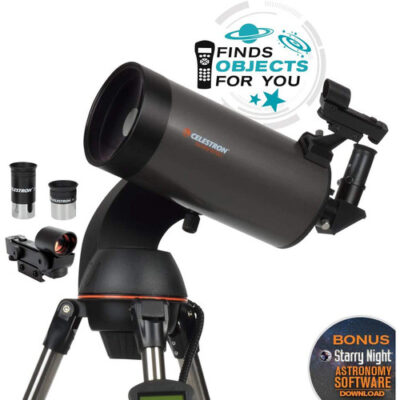
The Celestron NexStar GoTo mounts are powered by eight AA user-supplied batteries, or an optional AC adapter, making them perfect as a travel telescope.
With Celestron’s SkyAlign Technology, aligning your telescope is fast and easy. Simply input the date, time and location (the CPC models have built-in GPS that does this for you) and then align the telescope to three bright stars of your choosing.
You do not need to know the names of the stars, you can even pick the moon or bright planets. The NexStar computer system will automatically figure out which stars were chosen and then align the telescope.
The 127SLT’s diagonal is a prism, and a nice one at that – unlike the cheap diagonals supplied with many entry-level scopes which are cheap mirrors that aren’t very flat, which tend to offer dim and fuzzier images.
Pros:
- Super optical construction
- Very easy to operate with
- Compact and portable design
- Included needed additional accessories
- Suitable for lunar/planetary astrophotography
Cons:
- 8 AA batteries required but not included
- Tripod can be more stable
4. Celestron StarSense Explorer LT 114AZ Reflector Telescope
- SMARTPHONE-POWERED SKY TOUR: No experience needed! Just dock your phone, launch the StarSense Explorer app, and follow the on-screen arrows to locate stars, planets, nebulae, and more.
- PATENTED STARSENSE TECHNOLOGY: Unlike other astronomy apps, StarSense Explorer uses sky recognition technology to turn your phone into a celestial navigation system, analyzing star patterns overhead to pinpoint your telescope’s position.
- TONIGHT’S BEST TARGETS, INSTANTLY: The app generates a curated list of the top objects to see based on your time and location. See planets, bright nebulae, galaxies, and star clusters from the city—and even more from dark skies.
- SIMPLE SETUP, SMOOTH TRACKING: Features a manual altazimuth mount with altitude slow motion adjustment with a sliding rod. Follow the on-screen arrows to your target; when the bullseye turns green, you can view it clearly through the eyepiece.
- 114MM REFLECTOR WITH IMPRESSIVE VIEWS: The 4.5" Newtonian reflector with high-reflectivity coatings delivers sharp, vivid views of the Moon, planets like Jupiter and Saturn, and deep-sky favorites like the Orion Nebula and Andromeda Galaxy.
The Celestron StarSense Explorer LT 114AZ Reflector Telescope stands out in the intermediate category largely due to its StarSense smartphone-guided system, which turns your phone into a real-time sky navigator. Rather than hunting blindly with a manual setting circle or a traditional finderscope, you dock your smartphone into the telescope, launch the free app, and follow on-screen arrows that guide you to stars, planets, nebulae, and clusters based on your location.
This bridge between beginner ease and more serious stargazing tools makes it especially valuable for users who are past the basics but still want intuitive assistance without learning complex equatorial mounts or GoTo systems.
Optically, the LT 114AZ’s 114 mm Newtonian reflector gathers a good amount of light for its price point, delivering crisp views of the Moon’s craters, Saturn’s rings, Jupiter’s belts, and some brighter deep-sky objects. The included 25 mm and 10 mm eyepieces cover a useful magnification range for planetary and deep-sky viewing, and the slow-motion altitude and azimuth controls help you fine-tune your target once you’ve located it via the app.
While not as powerful as larger aperture scopes or as feature-rich as computerized GoTo mounts, this telescope delivers a satisfying balance of power and simplicity that suits enthusiasts who want more than a basic entry model but aren’t ready for advanced astrophotography rigs.
However, there are a few limitations to keep in mind at this intermediate level. The telescope doesn’t track automatically, so objects won’t stay centered indefinitely as the Earth rotates — something advanced users might miss if they’re used to motorized mounts. Additionally, while the StarSense system is helpful, it’s not a substitute for learning the night sky manually; it’s a guidance tool, not a fully automated GoTo computer.
Finally, some users note that accessories like eyepieces and mounts are serviceable but not premium, meaning you could want to upgrade them later as your skills grow. All that said, for an intermediate enthusiast who values ease of use and solid optical views without huge cost or complexity, this StarSense-enabled reflector is a compelling choice.
5. Smart Telescope from FASHIONARI
- Exceptional Optical Performance:Equipped with a powerful 80mm aperture and 300mm focal length (f/8.89), this telescope for adults delivers crystal-clear, bright views. The starlight-grade sensor supports up to 350X magnification for long-distance viewing and captures stunning 4K high-resolution images. even in low-light or moon-viewing conditions.
- Dual-Screen Display for Real-Time Viewing: This scope is equipped with not only an eyepiece with adjustable vision compensation (diopter adjustment range +/-4), but also a foldable external screen allows for direct, vivid observation. The built-in sunshade ensures clear visibility even under strong daylight, offering an intuitive viewing experience.
- One-Touch Switch Photo & Video Modes: Capture breathtaking photos or videos at the touch of a button—no external devices needed. Supports up to 512GB external storage, so you can save and share your favorite celestial moments anytime.
- Extended Battery Life & Auto Power-Off: Features a built-in 4500mAh high-capacity battery offering up to 6 hours of operation on a full charge. With customizable auto shut-off options (1/3/5/10 minutes), you can preserve battery life effortlessly.
- Versatile Use & Perfect Gift: Spotting Scope with Tripod for Target Shooting. Ideal for moon observation, stargazing, long-distance photography, and birdwatching. A perfect gift for astronomy enthusiasts and nature lovers alike.
The Smart Telescope from FASHIONARI bridges the gap between basic beginner telescopes and more advanced amateur gear by incorporating digital imaging and auto-focus technology into a classic refractor design. Its 80 mm aperture and ~300 mm focal length deliver bright, clear images suitable for lunar, planetary, and some deep-sky observations, while the starlight-grade sensor with up to ~350× magnification allows you to inspect details with more precision than typical entry-level scopes.
It also offers 4K photo and video capture on an internal and external screen, making this a good pick for hobbyists who want both observing and astrophotography features without needing separate gear.
One of this telescope’s strongest points as an intermediate instrument is its digital convenience: the built-in camera and dual displays make it easier to view and share the night sky with family or friends, and the auto-focus system simplifies getting clear views of celestial targets without manual focusing struggles.
The included mount and tripod make setup reasonably straightforward, and with long battery life (up to around 6 hours with the internal battery), extended observing sessions are more feasible. These features help reduce the learning curve for users who have outgrown purely optical beginner scopes but aren’t ready for fully computerized mounts or heavy astrophotography rigs.
However, there are some limitations that keep this telescope in the intermediate category rather than advanced territory. True enthusiasts may find that optical sharpness and tracking precision don’t match dedicated higher-end refractors or reflectors on equatorial mounts, and the digital imaging, while compelling, lacks the depth and flexibility of more specialized astrophotography setups.
The overall build and performance are best suited for casual deep-sky forays, moon and planet sessions, and introductory night-sky imaging, rather than rigorous scientific observation.
For hobby astronomers wanting a feature-rich step up from basic scopes — especially those who value easy digital viewing and imaging — this model offers a compelling balance of functionality and accessibility.
6. Dianfan 150EQ Astronomical Reflector Telescope
- 150mm Large Aperture: The Dianfan 150EQ astronomical telescope features a 150mm aperture and a 650mm focal length.Its powerful light-gathering ability delivers sharp,bright, clear images—perfect for beginners, experienced stargazers and families to explore the wonders of the night sky
- High Magnification & Flexible Viewing: Equipped with two eyepieces and a 2× Barlow lens, this telescope offers magnification from 26x–130x.It delivers detailed lunar views such as craters and lunar seas.It is great telescope for adults high powered
- Easy to assemble and use: Pre-assembled equatorial mount for convenience, it takes beginners about 20 minutes to set up the telescope.Enjoy smooth, precise tracking with a German-style new EQ mount featuring intuitive dials and slow-motion control cables. Ideal for exploring both the starry sky and distant landscapes, it offers inverted daytime views for terrestrial objects without affecting celestial observation
- Comprehensive Kit & Portability: It includes a red dot finderscope, a phone adapter, a moon filter and a carry bag for versatile use.Sturdy, custom-fit carrying bag is designed for easy transport and storage to protect the telescope. The bag measures 35.4 inches in length, 13.9 inches in width, and 9.4 inches in height, weighing 14 kg. It can be carried by hand or over the shoulder, offering convenient portability for outdoor stargazing
- Stable Tripod: Comes with a stainless steel tripod that provides solid support and stable views. The telescope height is 48.4–66.2 inches,it is easy to set up and user-friendly. Durable and reliable for every session,making stargazing and sky exploration effortless
The Dianfan 150EQ Astronomical Reflector Telescope brings large 150 mm aperture optics and a 650 mm focal length, giving it strong light-gathering ability that’s ideal for detailed views of the Moon, planets like Jupiter and Saturn, and even some brighter deep-sky objects such as star clusters and nebulae.
At this intermediate level, the reflector design combined with a manual German-style equatorial mount helps you make smoother, more precise movements across the night sky compared with basic alt-azimuth mounts, which is very useful when tracking celestial objects as Earth rotates.
Unlike entry-level telescopes that can feel limited in power and clarity, this model’s equatorial mount with slow-motion controls and the included 2× Barlow lens plus multiple eyepieces broaden your magnification options, helping you push beyond simple lunar observations into more engaging stargazing sessions
The phone adapter and moon filter are thoughtful additions — the phone adapter lets you try basic astrophotography or reference star maps, and the moon filter reduces glare for more comfortable viewing during bright lunar phases.
However, it’s still not a fully advanced telescope. Some users report that setup and focusing can be a bit fiddly without prior experience with equatorial mounts, and the stability and overall build quality may feel modest compared with premium intermediate models — meaning you may eventually consider upgrading components like the tripod or eyepieces as your skills grow.
But for an enthusiast moving past beginner gear, this reflector delivers significant optical capability and hands-on learning experiences at an accessible price, making it a rewarding choice for exploring the cosmos more deeply.
7. Celestron 114LCM Computerized Newtonian Telescope
- COMPUTERIZED AUTOMATIC TELESCOPE: The Celestron 114LCM Computerized Newtonian Telescope with all glass optics can automatically locate 4,000 celestial objects with its computerized GoTo mount.
- TAKE THE SKY TOUR: If you’re not sure of what to observe, the Sky Tour button will do the work for you. Simply press the button and your computerized telescope will generate a list of the best objects currently available to view in the sky.
- EVERYTHING YOU NEED: The Celestron LCM telescope comes with everything you need for stargazing, including a full-height tripod, 2 high-quality eyepieces (25mm & 9mm), and a StarPointer red dot finderscope.
- BONUS FREE STARRY NIGHT SOFTWARE: This Celestron 114LCM Computerized Telescope includes a FREE download of one of the top consumer rated astronomy software programs. Simulate the night sky from any location on Earth or plan your next observing session.
- UNBEATABLE WARRANTY & SUPPORT: Buy with confidence from Celestron, a leading telescope brand in California since 1960. Your purchase includes a 2-Year US Warranty and unlimited support from our team of US-based experts.
The Celestron 114LCM Computerized Newtonian Telescope offers a compelling step up for hobby astronomers who want automation without diving straight into premium gear. With a 114 mm aperture reflector and a fully computerized GoTo altazimuth mount, this telescope can automatically locate and track more than 4,000 celestial objects using the included NexStar hand controller and Celestron’s SkyAlign system — a major convenience for users who have outgrown manual finders but aren’t ready for complex equatorial mounts.
This means once you align the telescope on a few bright stars, it can guide you to planets, clusters, and nebulae with the touch of a button, making it ideal for intermediate stargazers who want to spend more time observing than searching.
Optically, the 114 mm reflector gathers significantly more light than smaller beginner scopes, revealing lunar craters crisply and providing satisfyingly bright views of Jupiter’s moons, Saturn’s rings, and many deep-sky objects that would otherwise be hard to find with simpler instruments.
Included 25 mm and 9 mm eyepieces give you useful magnification ranges for both wide-field and detailed viewing, and the StarPointer red-dot finder helps with quick pointing when you want to go manual.
For an intermediate enthusiast, this balance of automated object locating, decent aperture, and decent eyepiece selection makes it a solid performer for backyard astronomy sessions and introductory deep-sky exploration.
However, there are some caveats that keep it from being a truly advanced instrument.
While many users appreciate the computerized functionality, others note that alignment can be tricky, the mount and tripod feel a bit lightweight, and the instruction quality isn’t the best — so there is a learning curve before you get smooth operation.
Additionally, compared to higher-end GoTo telescopes, the included eyepieces and motor drive aren’t premium, and some experienced observers find that optics and tracking stability are modest at best.
That said, for someone ready to move beyond starter scopes and keen to explore the night sky with automated assistance, the 114LCM offers a rewarding blend of capability and convenience at a reasonable price.
Best Intermediate Telescope Buying Guide
Buying a telescope for home use is an important step towards a new level of appreciation for the night sky, and the wonders found within it.
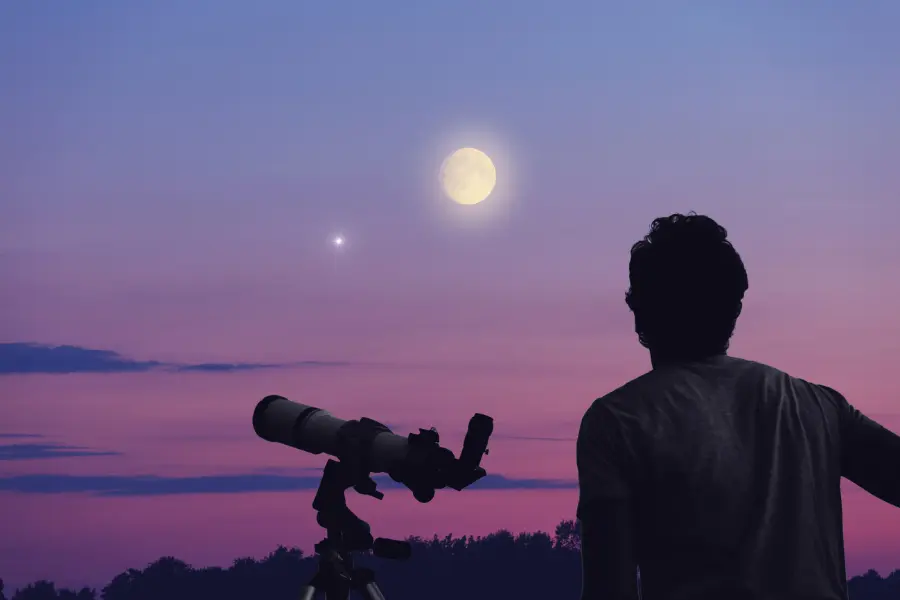
The decision to level up and purchase an intermediate telescope is huge, and if you choose the right product, it can completely change your life and how you view life on Earth.
The ability to see deep into the cosmos has a profound effect on most people, and fortunately, it’s much easier to do than you might think.
For a breathtaking planetary viewing experience every time, it is important to make sure you’re purchasing a quality product – not something you’ll find at most department-stores.
The telescope you want has two essentials: high-quality optics and a steady, smoothly working mount. You may also want the telescope to be nice and large, but don’t forget portability and convenience.
Features To Consider When Choosing A Good Intermediate Telescope
Aperture
The most important aspect of any telescope is its aperture, the diameter of its main optical component, which can be either a lens or a mirror.
The aperture of a telescope is the diameter of the light collecting region, assuming that the light collecting region has a circular geometry . For an optical instrument, the aperture is the diameter of the objective lens (refracting telescope) or the primary mirror (reflecting telescope). The larger the aperture, the more light the telescope can gather, and the fainter the limiting magnitude of the instrument. The field of view of the telescope decreases as the aperture increases, but the resolving power increases.
Focal Ratio
The focal ratio (f/5.9 for example) is the ratio between the aperture and the focal length. Multiply the aperture by the f ratio to find the focal length.
Focal Length
Focal length is the distance between a telescope’s primary optics and the image it creates. A longer focal length is more suited for observing planets, while a shorter focal length is better for wide field views of space.
Magnification
To get an image suitable for observing with our eyes, a telescope uses a second lens, or collection of lenses, called an eyepiece at the focal plane. The eyepiece magnifies the image from the objective.
The eyepiece also has a focal length. The magnification of a telescope and eyepiece is very simple to calculate. If the focal length of the objective is “F” and the focal length of the eyepiece is “f”, then the magnification of the telescope/eyepiece combination is F/f. For example, if a telescope has an objective lens with focal length of 1200 mm (about 48”) and it has an eyepiece of focal length 25 mm (about 1”), then it will have a magnification of 1200/25=48x.
Eyepieces
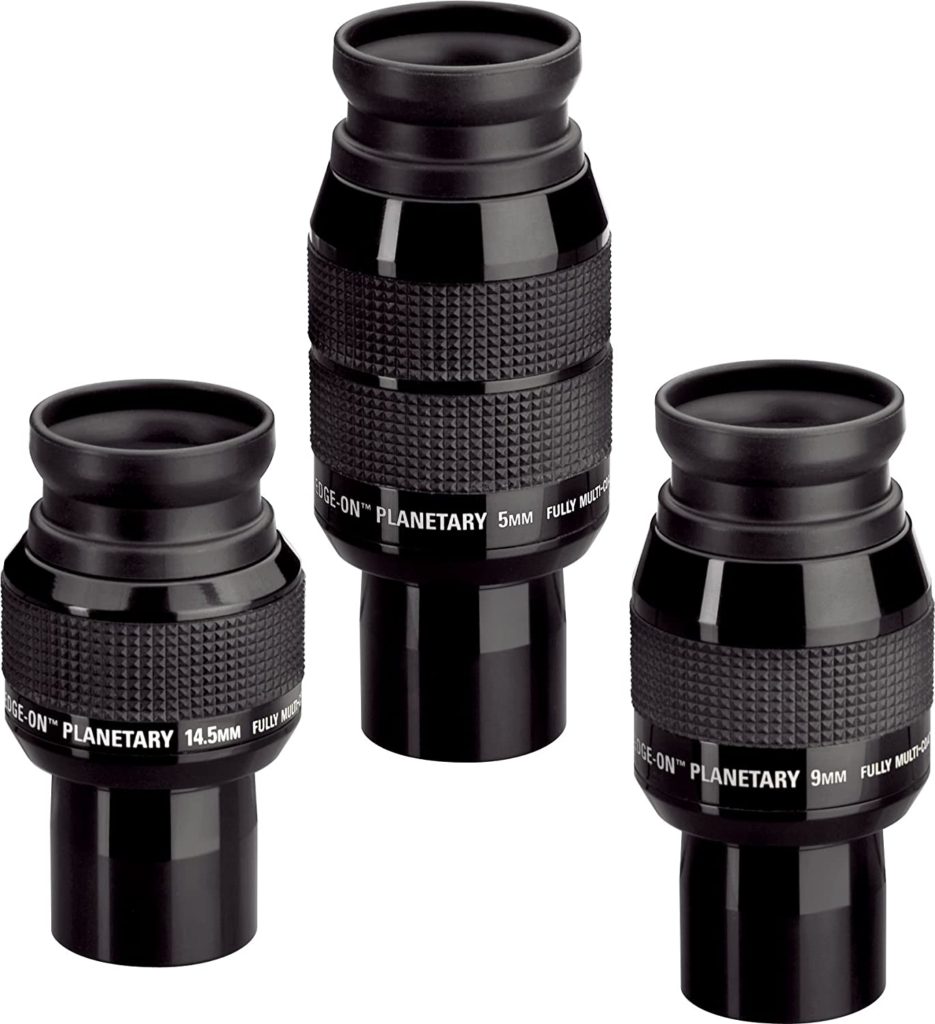
The eyepiece determines the magnification of the view through your telescope. Divide the focal length of your telescope by the focal length of the eyepiece to find the magnification. Eyepieces come in focal lengths ranging from 2mm to 56mm.
The highest useful magnification for a telescope is about twice the aperture size in mm. For example a telescope with a 150mm aperture is limited to a 300x magnification before the view will become too blurry. But this also depends on your atmospheric conditions while observing and on the quality of your optics.
Eyepieces come in 2 sizes: 1.25 inches and 2 inches. A 2″ eyepiece requires a 2″ focuser but a 1.25″ eyepiece is more versatile. It’s usually the higher end eyepieces that come in the 2″ size and they tend to be heavier and more expensive.
Types Of Mounts
The mount is a very important part of the telescope. Some types of telescopes are better suited for a particular type of mount. There are 4 main types.
Alt-Azimuth Mounts:
Alt-azimuth mounts are the simplest type of mount, and they are similar to a camera tripod. They allow you to move the telescope up and down and side to side. But it can be difficult to track the stars and make precise adjustments. For this reason they are mainly suited for smaller, low-power telescopes.
Equatorial Mounts:
Equatorial mounts allow a telescope to track the sky as Earth rotates. They do this with motor drives but do not necessarily require a computer system to track, although some equatorial mounts are computerized for finding objects.
Most equatorial mounts are German equatorial mounts, which use counterweights to balance the telescope. This type of mount is versatile and breaks down into smaller pieces, making even large telescopes portable.
Dobsonian Mounts:
The dobsonian is a variation of the alt-az mount, designed for reflectors. Instead of using tripod legs, it uses a heavy base that is often made of wood. This is a stable design that doesn’t cost a lot and allows for more precise movements.
Fork Mounts:
A fork mount is designed for shorter tube telescopes (usually the compound type). They are motorized and do not require a counterweight since the telescope is balanced at it’s center of mass. But they are often heavier than other types of mounts.
Types Of Telescopes
There are 3 main types of telescopes:
Refractor Telescopes:
This is the classic design that most people picture when they think of a telescope. Light enters through a lens at the top of the telescope before bouncing off a diagonal mirror at the bottom to the eyepiece. Smaller aperture refractors can be found for a low price, but larger aperture designs quickly become very expensive.
Reflector Telescopes:
A reflector telescope contains a large concave mirror at the bottom of a tube which bounces light toward a secondary mirror at the top and then to the eyepiece. Larger reflectors may use an open truss design instead of a tube to save weight. A reflector is one of the most cost-effective designs that allows you to get the most aperture for your money. This is especially true if used with a dobsonian base.
Compound Telescopes:
A compound (or catadioptric) telescope is made with a combination of mirrors and lenses. It is the most complex type, but this usually results in a more compact and lightweight design compared to the others.
Conclusion
Our top pick for the best intermediate telescope for beginners is the Celestron – AstroMaster 130EQ. Designed for near and deep-sky observation with a fast focal ratio for astrophotography/imaging, Celestron’s AstroMaster 130EQ 130mm f/5 Reflector Telescope features a 650mm focal length and an oversized parabolic mirror that produce detailed images of the Moon, clear views of the planets, and the ability to resolve distant objects such as nebulae and galaxies.
Our next best intermediate telescope for the money is the Celestron – NexStar 6SE Telescope. Its 6-inch aperture with excellent light-gathering ability provides impressive views of the Moon and planets, along with deep sky objects like the Orion Nebula, while retaining a compact form factor.
Also, the fully automated GoTo mount with a database of 40,000+ celestial objects automatically locates and tracks objects for you.
The Celestron – NexStar 127SLT is our pick for the best intermediate telescope for astrophotography.
Designed as an entry- to mid-level astronomical observation platform, the Celestron NexStar 127SLT 127mm f/12 Maksutov-Cassegrain GoTo Telescope gives users the ability to make detailed observations of the Moon, with the ability to easily see planets and reach outside the solar system to resolve distant objects like galaxies, nebulae, and binary or variable stars.
ABOUT US
We are a team of active amateur astronomers, here to help you with all your astronomy and science related needs – this is anything, from reviewing the latest telescopes to be released to talking about gravity and neurons. The Big Bang Optics was started because of our love for astronomy and to help others like us find the best telescope and accessories.
LEGAL DISCLAIMER
The Big Bang Optics is a participant in the Amazon Services LLC Associates Program, an affiliate advertising program designed to provide a means for sites to earn advertising fees by advertising and linking to Amazon.com. The Big Bang Optics also participates in affiliate programs with Clickbank and other sites. The Big Bang Optics is compensated for referring traffic and business to these companies.








